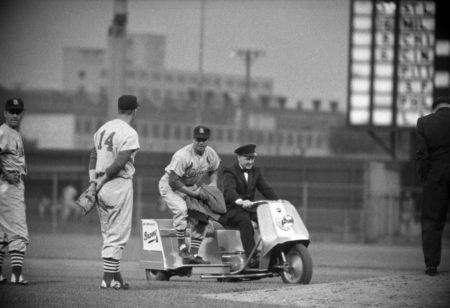You Want Speedier Games? Limit Pitching Changes—Part III
 This is the third installment of a three-part series taking a look at baseball’s pace of play. See Part I and Part II.
This is the third installment of a three-part series taking a look at baseball’s pace of play. See Part I and Part II.
So, what can be done to address the problem?
Some baseball people are urging that baseball institute a new rule that says a relief pitcher must face at least three hitters before he can be replaced.
Why only three batters?
Why not one inning? You pitch until you record the third out of an outing, should it extend over two innings.
That would speed up a game. And if the pitcher brought in cannot get those three outs before giving up six runs or however many, a team gets one free “get out of jail pass” per game to remove that pitcher after he’s faced at least three batters—whether or not he recorded an out (if it’s decided a relief pitcher must record at least one out per appearance, rather than three).
I like the idea that every pitcher must record three outs. It would allow the hitter to face a pitcher who might tire once he throws more than 20 pitches in an inning. And if the reliever doesn’t have it, the team at bat is rewarded with more chances to batter this pitcher until he records at least one out. The manager of the other team can use his one “get out of jail free” ticket and remove the pitcher from the game. But that is it. Next pitcher who enters the game must get three outs. And if eight runs score during those three outs, so be it.
I don’t think I’ve ever seen a pitcher suffer so much ignominy in one 15 minute span as Jonathan Holder of the New York Yankees did in the bottom of the fourth inning of the first game of the Yankee-Boston series on August 2, 2018.
Holder’s pitching line: no innings pitched, seven runs allowed on five hits and a walk. Holder threw 25 ineffective meatballs that were smashed off walls, over fences (thanks to Steve Pearce who cameoed for Jimmy Fox over two evenings—smashing four home runs in the first two games), crammed through the infield and you name it.
When Holder left, he looked as if he had contracted food poisoning or some other debilitating illness that required immediate medical attention, even though the score was only 8-4 and the Yankees were still in the game. Had my new rule above been adopted, the Yankees would have used their one “get out of jail free” ticket, and Holder would have been removed. But then, the next pitcher would’ve been forced to retire three batters before being removed.
Chad Green, the next pitcher, entered and, out of character, he also made matters worse. In 2/3 of an inning, he allowed a run on three hits and was the second pitcher Boston embarrassed. Aaron Boone grabbed the ball, but he would have been forced to let Green record one more out under this rule. So even though Boone took the ball, turned the other way, and glared, the score at that moment was 9-4. Imagine if it was 18-4 or worse?
Then there would have no longer been any pretense of hope. Though in reality the moment I heard Luis Cessa was replacing Green, I knew that meant desperation. The Yankees had publicly announced there was no longer a hope of winning this game. But, following the rule, Cessa could not have been removed until he recorded the third out.
The Yankees used four pitchers in that inning, Sabathia and three relievers, but what an inning. Boston fans were ebullient. Every Bostonian was standing and screaming. Yankee fans were suffering. That half inning was a horror show. That could have been Boris Karloff on the mound, followed by Vincent Price and Lon Cheney, it was that ghoulish.
That half-inning in Boston was a good example of how the three out rule could have worked. Had Holder been forced to get three outs, his lack of control would have added countless more action to the game and served as a reminder to baseball teams to choose their relief pitchers with care in an important game. Not that Holder was a bad choice, he just did not have it that night.
By implementing this idea, fans will not have to twiddle their thumbs while managers remove one pitcher after another. There won’t be the two minutes or so wait for the pitcher to get to the mound, speak briefly to the manager, and then begin warming up as the manager departs. There won’t be the minute or so of commercials run on television before returning to the game.
The rhythm and continuity of the game will not be broken as often. This could be a difference maker.
The problem is the problem is not only inside the game. The cost of a game is an issue.
It’s expensive to see baseball games in major markets. And the exorbitant salaries paid to players are the other side of the story. Because owners don’t cut their profits to pay players, they raise ticket prices, merchandise prices, or parking charges. All of these expenses are borne by the fan.
The question isÚ is any player worth $30 million dollars a year? Or $20 million? Wouldn’t it make sense for owners to reduce ticket prices unilaterally? Grow their business by increasing volume at games. Then negotiate with players to cut salaries as part of the plan. Clearly there would be resistance, but if it can be shown that lower ticket prices increase fan attendance, wouldn’t the chance to breathe new life into the game be worth the risk?
So what will breathe life into baseball? The 30-second pitch delivery clock? No. It’s ludicrous. I also think the automatic intentional base on balls was a ridiculous idea, since throwing four balls was sometimes botched. Now, I barely notice an intentional walk. And I have to be reminded the play is even in the game. I miss the intentional walk.
Reducing the parade of relief pitchers to the mound would be a welcome relief. It might also discourage the use of the lefty specialist who appears and disappears magically, slowing the game to crawl for ten minutes or so.
I think it’s worth a try. A proposal that does not change the essential beauty of the game while injecting more suspense into the drama is worth a try. Forcing relief pitchers to record three outs could be a very good idea for baseball.
























